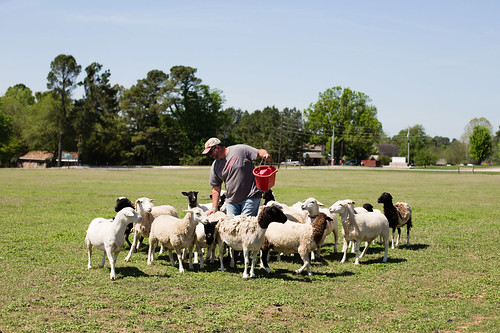Hardy sheep helps animal science researchers study forage and its byproducts
June 29, 2018
By Sarah Cato
U of A System Division of Agriculture
Fast facts:
- Animal science researchers acquire dorper sheep herd
- Dorper sheep are smaller, easier to work with
- Will be used for rumen research, potential for more
(600 words)
(Newsrooms - with downloadable images here: https://flic.kr/s/aHsmehCFvS )
Download Word version
FAYETTEVILLE, Ark. – Dorper sheep, a hardy breed with a healthy appetite, are helping animal science researchers at the University of Arkansas System Division of Agriculture examine forage and ruminant digestion.
Ken Coffey, animal science professor for the University of Arkansas System Division Of Agriculture, said that in the past, the Division of Agriculture’s animal science department bought lambs as they began different studies. However, this method consistently presented many issues.

“Prior to establishing the Dorper flock, we were having to buy lambs when we had studies planned,” Coffey said. “This often resulted in a number of problems and sometimes a problem with uniformity. We knew nothing about their genetics, health status or age.”
After working with an inconsistent herd of hair ewes, Darren Bignar, program technician for the Division of Agriculture’s animal science department, began researching different breeds and decided to look into dorper sheep. After researching this kind of breed, Bignar decided they were a good fit.
Dorper sheep originated in South Africa from the crossing of Dorset Horn with Black-headed Persian sheep. There are black-headed and all-white varieties. The herd at the Fayetteville farm consists of both.
The department is currently working with 39 ewe lambs, but plans to keep a smaller herd.
“Going down to 30 to 35 lambs will allow us to cull off the low end, lower quality poorer performing ewes to enhance uniformity,” Coffey said.
Bignar said working with dorper sheep, as opposed to other ruminant animals, offers a variety of advantages.
“We like that they’re very heat, cold and parasite resistant,” Bignar said. “We needed a good, small sheep that wouldn’t shed. Also, the babies are born the same size at the same time, giving us a uniform animal to work with.”
Coffey said the dorper sheep will be used for digestion studies.
“We are looking at the different forage composition and how it affects the urine and feces,” Coffey said. “Then we apply the urine and feces to the soil and look at gas emissions. We’re trying to see how can manage the diet to reduce environmental impact.”
Although the sheep are being used as a model for ruminant research, they bring the potential for more.
“I’d also like to do grazing research and co-graze the dorper sheep with cattle. The dorper sheep will eat things the cattle won’t, so if you have 100 different forage species the cattle may only eat 15,” Dirk Phillip, associate professor for animal science for the University of Arkansas System Division of Agriculture, said. “However, because dorper sheep have a diverse appetite, if you co-graze them the forage species composition may shift.”
Bignar said, because dorper sheep have simplified current projects so much, he thinks this breed has open doors for future projects that may not have worked with larger animals.
“I’m really pleased with this breed so far,” he said. “I can’t wait to see what comes of this in two to five years. Our imagination is the limit.”
Bignar said the animals’ tame demeanor makes them pleasant to work with.
“They’re really neat,” Bignar said. “You can just shake a bucket and they’ll follow you anywhere.”
Phillip said all these unique characteristics, among others, make dorper sheep ideal for their operation.
“I am very excited that we have the opportunity to work with these sheep. They are very different than cattle because of their size and their eating habits,” Philipp said. “These sheep eat things that cattle usually won’t, therefore they make good use of the forage we have.”
For more information on animal science projects visit aaes.uark.edu.
About the Division of Agriculture
The University of Arkansas System Division of Agriculture’s mission is to strengthen agriculture, communities, and families by connecting trusted research to the adoption of best practices. Through the Agricultural Experiment Station and the Cooperative Extension Service, the Division of Agriculture conducts research and extension work within the nation’s historic land grant education system.
The Division of Agriculture is one of 20 entities within the University of Arkansas System. It has offices in all 75 counties in Arkansas and faculty on five system campuses.
Pursuant to 7 CFR § 15.3, the University of Arkansas System Division of Agriculture offers all its Extension and Research programs and services (including employment) without regard to race, color, sex, national origin, religion, age, disability, marital or veteran status, genetic information, sexual preference, pregnancy or any other legally protected status, and is an equal opportunity institution.
# # #
Media Contact: Mary Hightower
Dir. of Communication Services
U of A System Division of Agriculture
Cooperative Extension Service
(501) 671-2126
mhightower@uada.edu